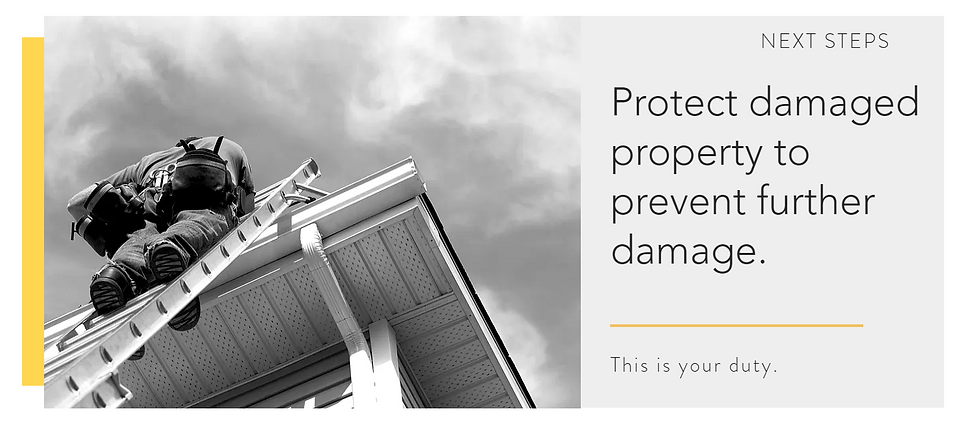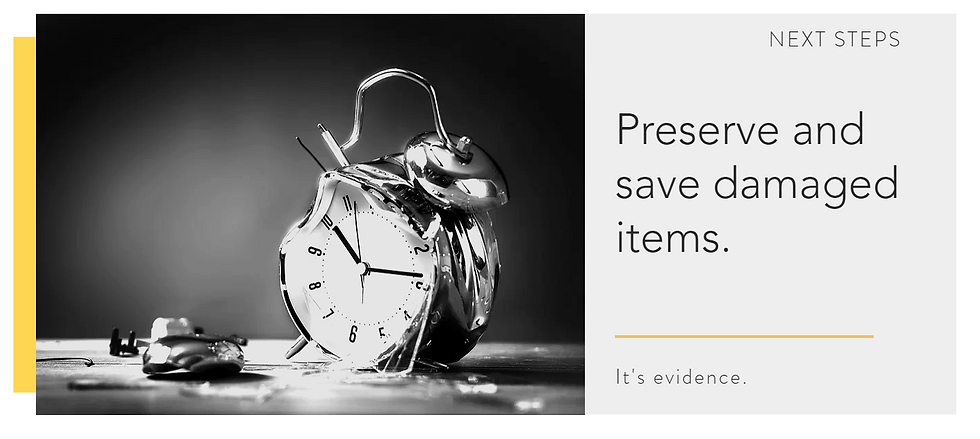Steps to Protect and Preserve Your Property Insurance Claim
- Luisa

- Apr 2, 2021
- 3 min read
Updated: Sep 3, 2021


Even if you don’t know the full extent of the damages, report your claim to your insurer as soon as you become aware of - or even suspect damage. Your insurance company will set up a claim and have a loss adjustor contact you to discuss your loss and arrange an inspection of your property.

Anything you tell the adjustor could be used against you later in the claim. Keep to the facts of what you know happened. Do not speculate or offer information. It is the adjustor’s job to investigate the loss. Prior to meeting with the loss adjustor, examine and document the damage.
Examine the Damage
Examine all the damage to your property as the result of the loss. Be prepared to walk the adjustor through the premises and point out the damage during your first “walk through” with the adjustor. Again, less is more with what you say during this walk through. After all, he or she will not be on your side. You are not required to guess or speculate as to the cause, nature or extent of the damage. That is the job for the adjustor and, later, his or her consultants.
Document Your Loss
Video and photograph the damaged property as soon as possible. This is will be invaluable down the line. You will provide these videos and photos to the loss adjustor to document your loss.

Keep a log of all communications with the loss adjustor regarding your claim. Include written correspondence, phone calls, voice mails, and email messages with the loss adjustor.

The policy requires you to prevent further damage to property after a loss. For example, it may be necessary to complete emergency repairs to prevent further damage. These may include turning off broken water supply lines, boarding up broken windows, placing a tarp on a damaged roof or having standing water removed from the property to begin the drying process. This is your duty under the terms of the policy. Your insurer will likely contend that it is not required to pay for additional damage that you arguably could have prevented. Note that you will be able to claim reimbursement for the cost of these temporary repairs. Therefore maintain the receipts for all purchases or services needed to make temporary emergency repairs.

You will want to clean up and throw out items that are beyond repair. However, they are evidence of your loss, and you will need to preserve them to show to the insurance adjustor. If it is not possible to preserve them, make sure you take copious videos and photos to document your loss before disposing of them.

Save the originals of receipts for all costs and expenses incurred after the loss such as for emergency repairs and living expenses. For example, most homeowners policies provide additional living expense (“ALE”) coverage which pays for expenses incurred when your home is unlivable due to the loss. This can include expenses for food and lodging and other costs associated with maintaining your household. You will provide copies of these receipts to the loss adjustor.

Prepare a complete inventory of missing and damaged items. Obtain and save the originals of receipts for all damaged items purchased prior to the loss. Your inventory will undoubtedly include numerous items for which you have no receipt. That’s ok. You are entitled to recover everything from soup to nuts. This is an arduous task, but the more comprehensive your inventory the more you will maximize your recovery.

You are not required to, and seldom should, use the insurance company’s contractors. Remember their allegiance will be to the insurance company from where the next job will come – Not You! The insurer’s contractors’ estimated repair costs will invariably be lower than what it will truly cost to repair your property and make you whole again. You will need your own contractors’ estimates to force the insurance company to pay what is owed under the policy.

Although the insurer creates, generates and maintains your claim file, it is your property – not the insurer’s. You can and should request a copy of your claim file regularly during the claim process. This will remind the insurer to look out for your interests first.

Make sure you understand the consequences of your John Hancock prior to signing. The only document you are required to sign is a proof of loss.
Overwhelmed? The Gorilla is here to help!
Sign up at: https://gorillalegal.typeform.com/to/pW4aDX6j



Comments